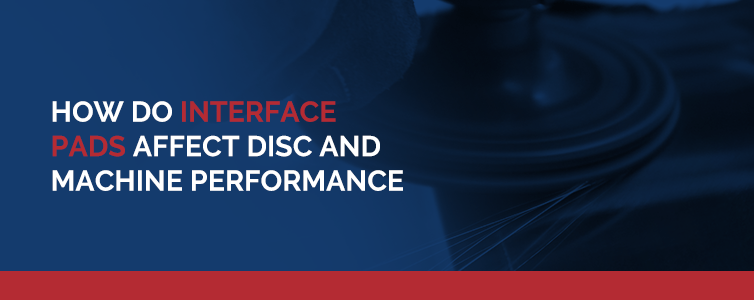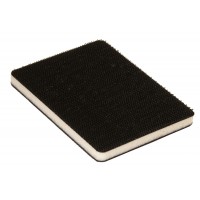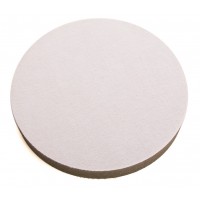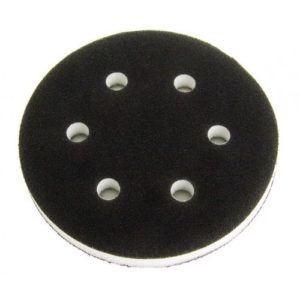
Interface pads, also called backup pads, offer a smoother sand and more flexibility for a variety of projects. The soft interface pad goes directly between the sander backing plate and the abrasive disk of a powered sander. Its main purpose is to provide an even sand for contoured edges or detailed projects, by creating a flexible abrasive surface. These sanding interface pads also help to evenly distribute rough machine movements and balance uneven pressure that may be applied to it.
Using an interface pad is a great way to get a more even finish or polish and reduce the hills and valleys caused by powerful machinery. These pads are commonly used with random orbital sanders. Pads can also reduce swirls and other effects, as well as allow you to access more difficult-to-reach areas.
In this article, we’ll go over everything you need to know about using and choosing an interface pad and how interface pads affect disc and machine performance.
Why Use an Interface Pad With a Sander?
There are many factors that can affect the smoothness of your sand, like the size and shape of the surface, the grit of the abrasive and the pressure of the machine. An interface pad can influence all these factors, but if you understand how they work, you can use an interface pad in the right situations and in the right way.
Interface pads offer several benefits to both you and your work, including:
- An increase in disc flexibility, precise detail work and movement around contoured edges
- Evenly distributed pressure, which can work well on both complicated pieces or simple, flat surfaces
- More comfortable to use, decreasing ergonomic issues and making the process more enjoyable
- Better control of the machine, leading to better performance
- Less wear and tear, which can increase the life of your discs and machine
1. Flexibility
The interface pad provides an extra layer of cushion, allowing the disc to move more freely against it before your abrasive hits the surface. This can be good for curved or complicated surfaces. Your disc will conform to a rounded edge and sand it as easily as it would a flat surface, preventing jagged edges or an uneven sand.
2. Even Pressure
With an interface pad, the pressure from the machine is spread out, making it more consistent across your surface. Even pressure will offer clear improvements, especially on delicate or soft surfaces where nicks and gouges are more noticeable.
The consistency you can get from using an interface pad makes them great for flat surfaces as well. Human error could lead to increased pressure on one side or holding the machine at an angle. This natural movement might cause divots or an uneven surface. A pad will absorb these movements and redistribute the pressure more evenly, so you get a smooth, even finish.
3. Comfort
The cushion of an interface pad helps to absorb vibration, particularly the lateral side-to-side movements of a strong sander. A comfortable machine with less vibration can help lower your risk of ergonomic-related injuries. Hand-arm vibration has been attributed to carpal tunnel syndrome and directly injures the fingers and hands. It restricts blood flow to these extremities and can affect your feeling, dexterity and grip. An ergonomic injury like carpal tunnel syndrome in a shop environment can be detrimental to your work. Any effort to reduce vibration risks can help immensely.
4. Control
Any machine with this type of motion can be difficult to control, but working with an uneven surface can make it especially temperamental. The sander can wander in another direction or jerk across the surface erratically. Of course, this can lead to dips and nicks in the surface you are working on, but it can also be a hazard to your workshop. Uncontrollable machinery at high velocities are accidents waiting to happen. An interface pad can help with this. The increased flexibility and redistribution of pressure that a pad offers can make a sander much easier to control and safer for your workplace.
In addition to increased safety, enhanced control offers you better influence over how your sand affects your project. You can more easily direct your sander where it needs to go and adjust pressure accordingly, so you see even results.
5. Materials
An interface pad generally softens the impact that your sander and discs see. The cushioning effect makes the powerful vibrations of your machine less damaging to the materials. It can slow down the wear and tear process and keep your discs running better.
All these features can provide your finished product with a higher standard of quality and improve the efficiency of your work and environment. The interface pad is great to use with many types of sanding, offering smoother results that won’t ruin a delicate or curvy piece.
What Sanders Can I Use an Interface Pad With?
You can use an interface pad with almost any machine using an abrasive disk. With an interface pad, you are typically looking for something that will work on a complex surface and give you soft and smooth results with no swirls, marks or moons. An interface pad can help you lose those unwanted effects by providing a more even polish, regardless of the machine.
Interface pads can offer their benefits to a multitude of project types, including those that require different machines. They can work with some of the most commonly used and general-purpose sanders available. An interface pad will work with several types of sanders, electric or pneumatic, which all affect an accompanying interface pad in subtly different ways.
- Orbital sanders rotate the square piece of sandpaper in a circular motion, while rotary sanders spin a wheel-shaped disc in a circular motion. Both can typically be used one-handed and offer cordless options. An orbital sander is better for lighter work or detailing, but a rotary sander offers more power for effective removal. An interface pad may prove useful here since these sanders can result in swirls and marks due to their motion. A pad can provide more even coverage.
- Combining the benefits of the two is a random orbital sander, also referred to as a dual-action (DA) sander, which both rotates and spins the disc in a circular motion. The random orbital sander offers more versatility in its use and is more of a general-purpose sander. It can also be used for many buffing and polishing applications.
- Detail sanders are shaped a little more like an iron. These sanders offer flexibility to get into hard-to-reach places on your project.
National Abrasives, Inc. is an authorized distributor of Mirka products, which are known for their resilience, durability and power. We offer selections of both electric and pneumatic random orbital sanders, as well as self-generating vacuum sanders, many of which will work well with interface pads. Check out our individual product pages to learn more about them.
Knowing how your sander operates is an important part of choosing materials that will work well with it.
Most sanding interface pads use a standard hook-and-loop design for attaching to the abrasive disc. This design allows your sanding discs and strips to stick to the pad easily and peel off. Hook-and-loop systems work like Velcro and attach to your abrasive. The side that attaches to the sander backing plate on the machine is typically pressure-sensitive adhesive (PSA) — which is essentially a sticker hook-and-loop. Interface pads are available for most types of sanders, and many will also have heat-dissipating holes to help lower the surface temperature as you sand.
Thickness is another aspect you’ll notice can vary greatly with interface pads. Some factors that you may want to consider when selecting a thickness are:
- Your sander backing plate: A thicker interface pad will protect your sander from wear and tear and excessive pressure. If this is your main goal in using an interface pad, look for one that is thick. High-density interface pads can be used for this purpose as well.
- Fineness of abrasive: You may want a thinner interface pad if you’re working with very fine grit. This ensures that the interface pad doesn’t provide so much cushion that it renders the sander ineffective. You’ll want to find that happy medium.
- Surface: Just as you weigh your options of grit, you’ll have to decide how the thickness of your interface pad, combined with your abrasive and machine, will affect your surface. A thicker interface pad will soften a fine sand and a thinner one will have less of an effect, but may be necessary for contour work. The size of your contour will also influence the size of your interface pad. Projects with large, rounded contours may need thicker interface pads, to allow for more movement and flexibility of the abrasive disc.
Interface pads can be used with a wide variety of discs and materials. They can be used on wood to achieve a soft finish on a curved surface, or on plastics to smooth down sharp edges. There are even interface pads that you can use with grinders for metal applications. In addition to sanding and metalwork, you can also use interface pads with buffing and polishing, and pads can be used on paint and ceramics too.
Take a look at our wide selection of Mirka products for various sanding tools that might meet your application needs.
How Interface Pads Affect Disc Performance
Your interface pad is not a one-size-fits-all situation. You’ll need to understand how your combination of abrasives and interface pad work with your machine and the surface you’re working on.
Abrasive discs can have a variety of backing types which interact with the interface pad, particularly in terms of flexibility. Generally, the more heavy-duty the backing is, the longer it will last.
- Cloth–backed abrasives can vary in flexibility from hard to lightweight but are generally considered a highly flexible option.
- Paper backings can similarly vary depending on their intended use and are measured by paper weight. Paper meant for power tools will likely be thicker than paper meant for hand sanding. Regardless of their thickness, these are not intended for wet sanding. Most of these are not particularly flexible.
- Fiber discs are hard and denser than cloth.
Thicker and rougher abrasives will require thicker interface pads to achieve the desired effect. An interface pad can be used with the right disc to remove things like metal, ceramics, glass, plastics and paint from a surface.
One feature to look out for is heat-dissipating holes in your interface pads. As the name suggests, they can help lower the temperature so you can avoid excessive heat while sanding. These holes should pair up with the matching holes on the abrasive disc. If you have a vacuum-powered system, this will also provide the vacuum access to the work surface. Using a vacuum helps to keep your area clean and improve the safety of your shop.
An interface pad will also lessen the harshness of a disc. You may want this lightened effect for delicate items or if you’re using a disc that’s firm and needs more flexibility to avoid damaging your work. You’ll have to keep the disc material in mind when working with a product that will influence its effect on your surface.
Discs can be made from a variety of materials. Aluminum oxide is popular because of its versatility. With a wide range of grits and uses, like wood, drywall and metal, and different types of chemical additions, aluminum oxide discs can cover a lot of ground. This category of discs includes titanium for toughness, calcined or platelet aluminas for fine grit and polishing, and ceramics for cooler and faster grinding applications and “self-sharpening” structures.
Other categories of abrasive materials include:
- Ceramic, for heavy metal removal. Ceramic is available in medium to extremely coarse grits.
- Emery, for metal polishing, due to it being flexible and not excessively abrasive. Emery is typically a coarser grit backed in cloth.
- Garnet, for light-duty wood sanding, paint removal, and metal smoothing. Garnet is often backed with paper and is available in finer grits.
- Silicon Carbide, for smoothing wood, plastic, glass, ceramic, and nonferrous metals such as brass and titanium. Silicon Carbide is often on waterproof paper and is available in fine to ultrafine.
- Zirconia Alumina, for metal removal and weld smoothing. Zirconia Alumina is available in medium to extremely coarse grits.
These types of abrasives have characteristics that will make them respond differently when used with an interface pad. Emery, for example, is already a flexible abrasive, so it probably won’t need a particularly thick interface pad to gain the benefits of flexibility that the pad offers.
You’ll need to consider the different effects that the materials will have on your surface and how an interface pad can help or hinder them. Clearly define your goal — smoothing, polishing, removal, etc. — and keep each piece of the puzzle in mind when choosing your materials and thinking about how they will interact with each other.
If you decide to use an interface pad with low-density foam, make sure you keep an eye on the speed of your sanding. With a foam that has give, the motion that the sander creates may be lost to the interface pad, instead of letting it transfer to the sanding disk. It could make your sanding less effective by reducing the machine’s movements.
You’ll also need to consider the speed that you’ll be using with each size disc. For Mirka products, we suggest the following limits.
- For 8-inch pads: 10,000 RPM
- For 5- and 6-inch pads: 12,000 RPM
- For 3-inch pads: 13,000 RPM
How Interface Pads Affect Machine Performance
An interface pad can also affect the way your machine performs, from the power it provides to the movement it generates. You’ll want to consider the following aspects as you choose an interface pad:
1. Leveling
An interface pad’s effectiveness can vary quite a bit based on how much human error is involved in the control of the machine, particularly its level. A high-density pad or a difficult surface could affect your ability to keep the machine parallel to the surface.
Another factor to consider is how large the abrasive disc is. The wider your disc, the more surface area you have to control and the more difficult it may be to do so. However, a disc that’s too small can create digging at its edges and decrease the space you are leveling. It could make the surface uneven if you aren’t careful. You’ll need to select a size that is just right to avoid these pitfalls.
2. Machine Stroke
Machine stroke is the diameter of the backing plate’s path across the surface. It is measured as the distance between the axis of the driveshaft and the axis of the backing plate or its mounting spindle, multiplied by two. A manufacturer may list this on packaging as “orbits per minute” or “revolutions per minute.”
- A large-stroke machine can generally give you more power by creating more movement between the materials you are working with, i.e. the abrasive and the surface. This movement can offer less buildup of debris which can help your disc last longer and work better, alongside the efficiency provided from a higher level of speed and abrasion. An interface pad will likely be more useful on a large-stroke sander because it won’t be as susceptible to the cushioning effect the foam causes from machine movement.
- A small-stroke sander is great for small projects because of its decreased movement, but it doesn’t offer the same degree of coverage as a large-stroke machine. It is, however, easier to control, as there is less side-to-side motion than that of a large-stroke machine. A soft interface pad can have a much more pronounced effect on a small-stroke machine, as it is likely to slow down its movements.
There are many variables and combinations of pressure and oscillation speeds that can impact the result of your work.
- Too much pressure: The incorrect pressure can eliminate the entire cushioning effect that the interface pad provides. If your speed isn’t high enough, the incorrect pressure could stop the backing plate’s rotation completely. This issue could damage your surface and harm the life of your disk.
- Too much speed: Working on too high of a speed without enough pressure can make your disc wobbly and gouge the edges of your surface. It may also generate a lot of heat, potentially harming your disc, interface pad or project surface.
The best approach would be to find a middle ground. Experiment and find out which combination works well with your project, abrasive and machine.
Start Using Interface Pads Today
National Abrasives, Inc. has been offering industry-leading power sanders and materials for over 20 years. As a family-owned and operated company based in central Pennsylvania, we understand what good customer service is. We have a wide collection of not only machinery but also the accessories you need to get the job done and keep your machine working smoothly.
If you need backing pads for your power sander, consider purchasing them from us today. We are an authorized distributor of Mirka products. Mirka offers reputable systems designed for many purposes, including effective and safe work. We offer same-day shipping on in-stock orders placed before 3 p.m. EST Monday through Friday, along with a convenient online store for easy 24-hour access. Bulk discounts and free shipping with qualifying minimum purchase amounts are a few of the ways that National Abrasives, Inc. can save you money.













